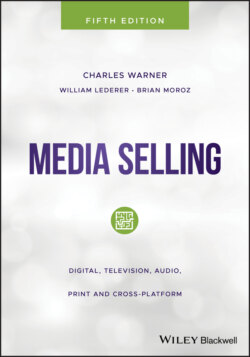Читать книгу Media Selling - Warner Charles Dudley - Страница 14
The Internet and Ad Words: Disrupting Marketing and Advertising
ОглавлениеThe Internet completely disrupted marketing. It switched the focus of marketing from mass marketing in the mass media to marketing to one individual at a time in customized, personalized, and fragmented media. In addition, the Internet allowed marketers to appeal to a narrow market of just one person out at the end of the long tail; to sell less of more, as Chris Anderson writes in The Long Tail.10
Not only did the Internet allow marketing to be more precise and more highly targeted, it also allowed consumers to discover a new product or service, to get more information about the product in the moment, without going to a retail store or dealership, and, probably most important, it allowed consumers to purchase a product online without going to a retail checkout counter. Thus, elements in the old value chain were upended; distribution costs and transaction costs were reduced to virtually zero – an enormous disruption.
Figure 1.1 The value chain
Let’s look at the steps in the value chain that companies had to go through in order to be successful:
The top step in each box (in gray, no parentheses) is the original one identified by Michael Porter in his 1998 book Competitive Advantage.11 Porter’s value chain obviously refers to a manufacturing or retail company, not a media or Internet company. The steps in the value chain that are in parentheses are more familiar and helpful in understanding the value chain process as it exists today, especially in companies such as Google, Facebook, and Amazon.
Before the advent of the Internet, large companies that were vertically integrated could control the three creation steps in the value chain (supply, production, and distribution) and could gain monopoly‐like market power, charge higher prices, and, therefore, achieve huge profit margins. For example, newspapers that controlled the scarce supply of news (skilled reporters who wrote news stories), owned expensive printing presses and delivery trucks and, thus, controlled production and distribution; therefore, they often gained monopoly‐pricing control over advertising. Newspapers, because they had an elastic supply of advertising inventory (they could add pages if demand for advertising went up), charged a fixed, non‐negotiable price and gave volume discounts to large advertisers. In other words, newspaper pricing strategy rewarded advertisers for buying more advertising lineage and buying it more frequently, and the newspapers could just add pages as demand went up. This pricing strategy was extremely profitable for newspapers, and also favored large advertisers, such as department stores that could buy advertising more cheaply than small retailers because of volume discounts. Thus, it was an advantage to be a large advertiser; the small corner dry cleaner couldn’t afford to advertise in a major newspaper and had to find other ways to market its business, such as advertising in Yellow Pages.
Another example of pre‐Internet advertising pricing strategies was how television networks determined pricing. Television programming had an inelastic supply of advertising inventory because programs were formatted for a fixed amount of advertising. Thus, a half‐hour news program was formatted for eight minutes of commercial time. Because of the inelastic supply of advertising slots and because there was high demand for a limited supply of television ad inventory, prices were not fixed and were determined by demand. The market determined prices, and thus each television commercial schedule was negotiated anew at the time an advertising campaign was placed. It was a pricing model based on scarcity and demand.
The prices for all media advertising were based on some version of a cost‐per‐thousand (CPM) model in which advertisers paid on the basis of having the opportunity to capture readers’, viewers’, or listeners’ attention. Advertisers purchased the opportunity for exposure, not based on whether anyone read, watched, or listened to an ad. Mass media advertising was, in a sense, a gamble that someone would see and respond to an ad immediately or sometime in the future.
John Wanamaker, a Philadelphia department store owner, famously said in the early 1900s, “I know that half my advertising is wasted. The problem is I don’t know which half.” So Wanamaker and other advertisers doubled down on advertising hoping that at least half of it would work.
Therefore, newspaper readers and television viewers were inundated with advertising whether or not the ads were relevant to their individual aspirations, needs, or desires. Television advertising was especially intrusive, but most viewers put up with it because of an implicit contract between television stations and networks and their viewers who got free entertainment and news in return for their attention.12
The introduction of the digital video recorder (DVR) in 1999 by TiVo allowed viewers to record programs and fast‐forward through commercials in the programs they recorded. This fast‐forwarding highlighted the fact that people were not happy about intrusive, irrelevant advertising and wanted to skip it.
